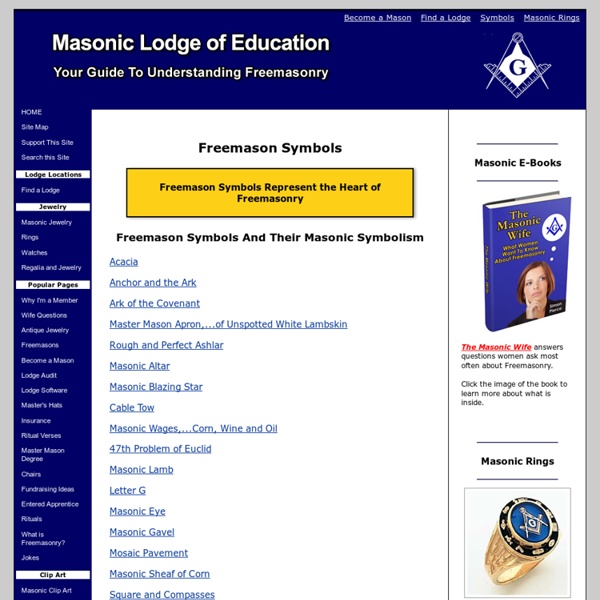Masonic Dictionary | Masonic Numbers | www.masonicdictionary.com
Of the five human senses, the three which are the most important in Masonic symbolism are Seeing, Hearing, and Feeling, because of their respective reference to certain modes of recognition, and because, by their use, Freemasons are enabled to practice that universal language the possession of which is the boast of the Order. - Source: Mackey's Encyclopedia of Freemasonry Four is the tetrad or Quaternary of the Pythagoreans! and it is a sacred number in the advanced Degrees. The Pythagoreans called it a perfect number, and hence it has been adopted as a sacred number in the Degree of Perfect Master. In many nations of antiquity the name of God consists of four letters, as the Adad, of the Syrians, the Amum of the Egyptians, the efos of the Greeks, the Deus of the Romans, and pre-eminently the Tetragrammaton or four-lettered name of the Jews. In Egypt, India. and other Oriental nations says Gesenius, the five minor planets and the five elementary powers were accounted sacred.
Witchcraft, Wiccan and Pagan Index | Celtic Connection
FREEMASONS | PS Review of Freemasonry
University of Bradford : Web of Hiram
This website began when Dr Robert Lomas of the University's School of Management, decided to create an electronic database of the Masonic material held in many of the University's Special Collections as part of his on-going research into the cultural origin of scientific ideas. As other material has been donated to this work it has been added to the archive. None of the rituals and statutes recorded in the data are currently in use. It is in effect a scrap heap of discarded ritual and belief. But just as an archaeologist can search through ancient midden heaps and in doing so discover a lot of information about the people who dumped the rubbish, so this archive gives valuable insight into the cultural contributions of Freemasonry. Whilst researching the book Turning the Hiram Key Dr Lomas obtained copies of out-of-copyright published material by the Masonic writer Walter Leslie Wilmshurst and transposed them into web-format.
witch
By Doreen Valiente Hear now the words of the witches, The secrets we hid in the night, When dark was our destiny’s pathway, That now we bring forth into the light. Mysterious water and fire, The earth and the wide-ranging air. By hidden quintessence we know them, And will and keep silent and dare. The birth and rebirth of all nature, The passing of winter and spring, We share with the life universal, Rejoice in the magickal ring. Four times in the year the Great Sabbat Returns, And the witches are seen, At Lammas and Candlemass dancing, On May Even and old Hallowe’en. When day-time and night-time are equal, When sun is at greatest and least, The four Lesser Sabbats are summoned, Again witches gather in feast. Thirteen silver moons in a year are, Thirteen is the coven’s array, Thirteen times at esbat make merry, For each golden year and a day. The power was passed down the ages, Each time between woman and man, Each century unto the other, Ere time and the ages began. The Witches' Rune
Alchimaer Art
The Degrees Of Masonry - Their Origins And History
by Bro A. L. Kress And Bro. R. J. Meekren Published in THE BUILDER MAGAZINE Every Mason has learned a traditional account of the various grades of Craft Masonry, and this term may be stretched to include more than the three degrees of the “Blue” or “Symbolic” Lodge, in especial the degrees of the Chapter and the Council. It is perhaps rather curious that, though there have been a good many articles in THE BUILDER upon the general subject of the degrees, and some dealing with the origins of the Third, or Master Mason’s Degree, yet there has been practically nothing about their origin as a system, although a good deal in regard to this has by many contributors been taken for granted. There are two works that are, however, readily available which contain dissertations upon our subject: Mackey’s History of Freemasonry and Gould’s Concise History. THE SCOPE OF THE Discussion The earlier Masonic writers accepted all the traditions and legends at their face value. We noted that Dr.
Freemasonry
Freemasonry is a fraternal organisation that traces its origins to the local fraternities of stonemasons, which from the end of the fourteenth century regulated the qualifications of masons and their interaction with authorities and clients. The degrees of freemasonry, its gradal system, retain the three grades of medieval craft guilds, those of Apprentice, journeyman or fellow (now called Fellowcraft), and Master Mason. These are the degrees offered by craft, or blue lodge Freemasonry. The basic, local organisational unit of Freemasonry is the lodge. Masonic Lodge Palazzo Roffia, Lodge in Italy set out for French (Moderns) ritual The Masonic Lodge is the basic organisational unit of Freemasonry. The bulk of Masonic ritual consists of degree ceremonies. Most lodges have some sort of social calendar, allowing Masons and their partners to meet in a less ritualised environment.[7] Often coupled with these events is the obligation placed on every Mason to contribute to charity. History



